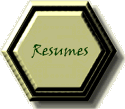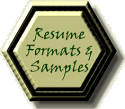Resume Tips & Resources

Resume Tips
Header
|
|
List your name, location, email and phone number at top of page one of your resume. |
|
|
Remember to number all pages (Page 1 of 1, Page 1 of 2, Page 2 of 2). Include your name and e-mail address on the second page. |
Dates
|
|
List years only, no months when giving dates. This helps avoid age discrimination. |
|
|
Remove dates entirely from your Education, except for special cases (you've just entered the work force, you need to show that a certification is current, or you need to cover gaps in your work history). |
|
|
Employers can ask ONLY for your dates of employment, not education dates or your age. |
|
|
Education dates ARE necessary for a background check. Since checks are usually conducted just prior to a job offer, be sure Human Resources has your education dates at that time. |
|
|
Avoid going further back than 15-20 years on your resume. 10-12 years work experience should be adequate, unless you were in the same position for over 20 years or the additional experience is especially relevant to the present position. |
Gaps in Work History
|
|
Did you do any volunteer work or any other type of unpaid employment? List just like regular employment. |
|
|
Were you self-employed or consulting during this time? List just like regular employment. |
|
|
Were you going to school full-time? Include dates for education in this case. |
|
|
List temp agencies as employers for temporary or part-time work. |
Omit
|
|
Jobs that were very brief or not relevant, unless needed to fill gaps or gain experience. |
|
|
Hobbies, personal attributes or statistics, photos (unless you're looking for a modeling job), salary information, or references. A resume with photos is often thrown away immediately as it poses a risk for accusations of discrimination if accepted. |
Keep
|
|
Margins at 1” for hard-copy resume, 1” on top & 1 ˝” on sides for e-resume. |
|
|
All bullet points at 1 to 2 lines each. |
|
|
Resume to 1 to 2 pages in length. Include only last 10-12 years of work experience. |
|
|
Your objective specific. If not specific, leave off resume. Always include on cover letter. |
Accomplishments
|
|
6-7 accomplishments per section |
|
|
State your accomplishments in terms of $, #, and time saved. |
|
|
Place the biggest accomplishment at the beginning of each section. |
|
|
Start each bulleted accomplishment with an action verb, past tense is best. |
|
|
Stress transferable skills if you are changing careers. |
Check for
|
|
Missing or inaccurate dates, incorrect grammar & spelling, false or exaggerated info. |
|
|
Food stains, torn or crumpled pages, staples, creases (mail flat in 8 x 12 envelope). |
|
|
Use of Me or I, long cumbersome sentences, non-relevant material. |
|
|
Obscure abbreviations or acronyms |
|
|
Use of brightly colored paper. Use white or light off-white paper. |
|
|
Use of hard-read fonts. Use Arial, 10 to 12, Time New Roman, 11 to 12, or Helvetica, 11 to 12, fonts. |
Text Resumes
|
|
Save the document as text without line breaks. This will convert your document to Notepad text (In Microsoft Office). |
|
|
Insert manual line breaks in your text document at 55 characters. Hint: at the top of the document, create a ruler by counting over 55 spaces and entering 55. Then when finished entering the line breaks, erase your ruler. |
|
|
Change bullets and asterisks to dashes. |
|
|
Your text resume may be longer than 2 pages. Remove any page break information as different e-mail programs will break your pages at different points. |
|
|
Add your name and email address at the end of the document as well as at the beginning. |
|
|
Sample Text Resume (not very pretty, is it!) |
Emailing Resumes
|
|
Resumes may be e-mailed as either attachment files or as a text resume embedded in the body of an e-mail. Follow the instructions given in the job posting. If no instructions are give, send as an attachment. |
|
|
Call your resume document 'Resume for Susan Jobseeker' rather than 'SusanResume12'. It will make it easier for a potential employer to find it in their e-mail files. |
|
|
Copy yourself on all resumes sent via e-mail. |
|
|
Before you send your first e-mail resume, send a trial run to yourself and two other people, preferably with different e-mail programs or Internet browsers than yours. If these come out okay, you can be confident that the majority of resumes you send will be received. |
|
|
Use the job number you are responding to in the subject line of your e-mail. |
|
|
Use key words from the job posting in your cover letter and resume. |
|
|
Always make a backup copy of ALL of your computer work! |
These tips cover some general questions about resumes. For more specific questions, check out The Damn Good Resume Guide's web site, a good resource for answers to some of the tougher resume questions.
Additional Resume Resources
If you have never written a resume before, you may want to check out the first section of The Damn Good Resume Guide by Yana Parker. The resumes in this book provide a good framework to start with, though they do tend to focus on duties and skills rather than skills and accomplishments. A good resume should change as you change, to accurately reflect your current focus. It will also grow and develop over time. The Damn Good Resume Guide provides a good beginning.
The following books may assist you in further developing your resume:
If you have been out of the job market and are now returning to work, check out Expert Resumes: People Returning to Work, by Wendy S. Enelow and Louise M. Kursmark.
If you need to update an existing resume and increase its effectiveness, try 100 Winning Resumes for $100,000+ Jobs, by Wendy Enelow, Best Resumes and CVs for International Jobs: Your Passport to the Global Market, by Ronald L. Krannich and Wendy S. Enelow, or Gallery of Best Resumes, 3rd Edition, by David F. Noble.
Another Wendy Enelow book, Winning Cover Letters for $100,000+ Jobs has some excellent cover letter examples.
Martin Yates’s Knock Em Dead series includes Knock Em Dead Resumes and Knock Em Dead Cover Letters. This is an excellent series of job seeker manuals.
The following websites provide resume and cover letter information:
http://www.damngood.com/introjobseeker.html
http://editorial.careers.msn.com/gettinghired/resumes/
http://www.careerjournal.com/jobhunting/resumes/
http://jobstar.org/tools/resume/index.cfm
Attend an Experience Unlimited group’s Resume Review workshop. This will provide you feedback from peers on the content and style of your resume. Resume Reviews are also often offered at local job fairs.
If you find yourself at an impasse, you may want to try working with a career coach to help you get started again. A coach can help you to see yourself in a new light and to begin to understand just how truly accomplished you really are.







